Less than a year after B.C. unveiled a program aimed at bringing foreign entrepreneurs to rural areas through fast-track immigration, some communities are already reporting a flood of interest from potential applicants.
But observers caution that previous attempts to bring business-class immigrants to rural areas of Canada faced serious challenges and ultimately failed due to economic realities and modern immigration trends. And, critics say, it remains to be seen if the new provincial pilot program can create lasting economic impact for the communities that desperately need it.
The program, a new variation of the Provincial Nominee Program (PNP) called the Entrepreneur Immigration Regional Pilot, was launched in March. It is a separate stream of the PNP in B.C., which allows approved applicants to quickly gain a temporary work permit in Canada provided they move to and start a new business in communities with under 75,000 in population outside metropolitan urban areas. By meeting certain conditions, the new entrepreneurs can become eligible for permanent residency after two years.
Among the more than 30 B.C. municipalities participating, some are already reporting record levels of interest from international entrepreneurs.Merritt, for example, has already had more than 80 inquiries in one month, and the municipality has already scheduled enough visits by potential applicants to fill at least the next two weeks.
“And there are still emails to be answered,” said Will George, Merritt’s economic development manager, who added the town would like to encourage businesses in the transportation and warehousing and retail sectors to take advantage of the municipality’s location.
“We hear over and over again that people are interested in Merritt for its close proximity to the Lower Mainland. We’ve had a lot of people come up and make those exploratory visits, and some people mention they have family members already in B.C. Being in Merritt means it’s just a skip and a jump to go to Kamloops, Kelowna or the Lower Mainland.”
The impetus for some municipalities, however, goes beyond attracting shops and businesses. For Williams Lake, which had mass evacuations caused by wildfires in 2017, the strategy is simply to recuperate and to attract newcomers to ensure the community has enough workers and services to recover fully. “One of the things we experienced after the 2017 fires was a real gap in our labour market,” said Williams Lake economic development officer Beth Veenkamp, who noted the town has received 30 to 40 inquiries from foreign entrepreneurs within the first few months of the program. “A lot of people had the opportunity to get out of town [because of the fires], so they relocated to other places, got jobs and started working in those communities.
We lost quite a few of our service industry workers during that time, and it really impacted the ability for local stores to reopen after the fires.
“We need to bring more people to the community, whether they are workers or entrepreneurs…. In order to make Williams Lake able to retain the people who are already here, we have to make it more livable, and so we need more services, more restaurants, more dynamism – just more.”
Provincial Minister of Jobs, Trade and Technology Bruce Ralston said the response from B.C.’s rural municipalities has been equally strong, noting several mayors have commented about their towns not getting “fair consideration” by foreign entrepreneurs prior to the pilot program’s initiation.
Ralston added that the province wasn’t solely concerned with smaller communities when it implemented the program, since rapid growth and foreign immigration/investment have put undue stresses on areas like Metro Vancouver in the past decade.
“There’s no doubt that in the Lower Mainland, on Vancouver Island and in the Okanagan where there is rapid growth, it brings with it some challenges,” he said. “Smaller communities have available housing and space in their schools, and they are welcoming communities who are very supportive of local business.”
However, this isn’t the first time Canadian government entities have tied entrepreneurship in less populated areas with fast-track immigration, and academics who have studied past cases noted that previous federal programs were far from successful in boosting the economies of smaller rural centres.
The Federal Immigrant Investor and Entrepreneurship Program, launched in the 1980s, attracted a large number of new immigrants predominantly from Asia for three decades and did not implement adequate monitoring for immigrant entrepreneurs’ performance in their new Canadian homes until around 2000. All the data since then appeared to point to a less-than-optimal result.




